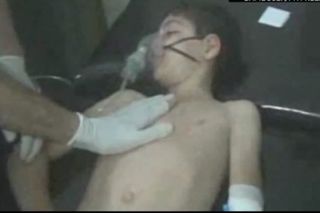Syria: What Is Poisonous Gas?

Updated on Friday, Aug. 30, at 10:15 a.m. ET.
Reports that the Syrian government has used poisonous gas against rebels in that country's civil insurrection have prompted the Obama administration to consider military action against the government of President Bashar al-Assad.
Though these reports have yet to be confirmed, many experts say the videos and photographs from Syria showing dead and injured people would be difficult to fake. Senior White House officials have evidence that the poison used was sarin gas, the Wall Street Journal reports. The Syrian government, however, has consistently denied all allegations of the use of poisonous gas or other chemical weapons.
Poisonous gas has a long, grim history of use in warfare. In the ancient Syrian city of Dura-Europos, the remains of about 20 soldiers from A.D. 256 were discovered by archaeologists in 1930. Recent chemical analysis revealed these soldiers were probably killed not by swords or spears, but by sulfur gases ignited by the invading Persian army. [The 10 Most Outrageous Military Experiments]
The use of poisonous gas and other chemical weapons was banned by the Geneva Protocol following World War I — sometimes referred to as "the chemists' war" — during which chlorine gas, tear gas (ethyl bromoacetate or chloroacetone), phosgene, mustard gas and other chemical agents were used by both sides.
Syria, however, is not a signatory to the U.N. Chemical Weapons Convention (which strengthened the Geneva Protocol), and in 2012 the Syrian government threatened to use chemical and biological weapons in case of an attack. Syria is widely recognized as having a large stockpile of chemical and biological weapons.
Effects of nerve agents
Sign up for the Live Science daily newsletter now
Get the world’s most fascinating discoveries delivered straight to your inbox.
Because the alleged poisonous gas attacks in Syria are unconfirmed, it can't be determined what type of poisonous gas (if any) is being used. However, Dr. Khaled al-Doumi, director of a medical center near the site of the alleged attack, told Al Jazeera, "Medically speaking, the symptoms indicate that poisoning was a result of phosphorous compounds that could be caused by organic insecticides or sarin gas."
Sarin gas is a man-made, lethal toxin with no color, taste or odor; it can be inhaled or absorbed through the skin or eyes. Sarin is a nerve agent that works on the central nervous system and prevents the body from "turning off" glands and muscles, so these are constantly stimulated. Even a small drop of sarin on the skin can cause someone to twitch and sweat profusely.
People exposed to large amounts of sarin quickly lose control over their bodily functions and, if not treated immediately, can fall into a coma or succumb to respiratory failure.
Organic insecticides, often referred to as organophosphates, also act on the nervous system in a way that's similar to sarin, causing overstimulation and neurological dysfunction. Death can come quickly, generally due to respiratory failure. (After the deaths of 23 children in India in July, officials blamed school lunches that were contaminated with organophosphate pesticide.)
Mustard gas stockpiles
According to the BBC, Syria also has large stockpiles of mustard gas, recognized as a poisonous gas since the 19th century. Also known as sulfur mustard, the compound is named for its distinctive mustard smell, which has also been compared to horseradish.
Mustard gas is a relatively slow-acting toxin, and symptoms of exposure may take up to 24 hours to develop. Skin exposure results in severe blisters; temporary blindness may result if the eyes were exposed. Inhalation can cause serious lung damage, and exposure to mustard gas can increase the risk of cancer.
There are a number of other chemical agents that could be used as poisonous gas, from chlorine gas (which was infamously used by the Germans with devastating effect in the Second Battle of Ypres during WWI) to 3-quinuclidinyl benzilate — sometimes called Agent 15, BZ or "Buzz" — an incapacitating nerve agent that causes stupor, confusion and hallucinations.
In January, Wired reported that Syrian government troops had used Agent 15 on the rebels, according to some U.S. diplomats, but those reports have not been confirmed. Many international observers believe it could be years before the extent of poisonous gas used in Syria — if any is used at all — can be verified.
Follow Marc Lallanilla on Twitter and Google+. Follow us @livescience, Facebook & Google+. Original article on LiveScience.

Most Popular


